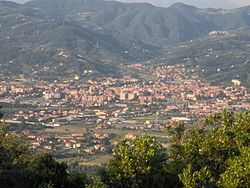Demonym(s) Sarzanesi Local time Wednesday 11:58 PM | Elevation 21 m (69 ft) | |
 | ||
Frazioni Marinella di Sarzana, Falcinello, Sarzanello, San Lazzaro Weather 12°C, Wind E at 10 km/h, 87% Humidity Points of interest Firmafede Fortress, Museo diocesano, Bozzi di Saudino, Palazzo Roderio, Porta Parma Sarzana | ||
Sarzana italy italien 18 10 2015
Sarzana ([sarˈdzaːna]) is a town, comune (municipality) and former short-lived Catholic bishopric in the Province of La Spezia, of Liguria region, northwestern Italy, 15 kilometres (9 mi) east of Spezia, on the railway to Pisa, at the point where the railway to Parma diverges to the north. In 2010 it had a population of 21,978.
Contents
- Sarzana italy italien 18 10 2015
- Map of Sarzana Province of La Spezia Italy
- Odifreddi a sarzana diamo spazio alla stupidit
- History
- Ecclesiastical History
- Main sights
- Notable locals
- Twin towns Sister cities
- Climate
- References
Map of Sarzana, Province of La Spezia, Italy
Odifreddi a sarzana diamo spazio alla stupidit
History
The position of Sarzana, at the entrance to the valley of the Magra (ancient Macra), the boundary between Etruria and Liguria in Roman times, gave it military importance in the Middle Ages. The first mention of the city is found in 983 in a diploma of Otto I; in 1202 the episcopal see was transferred from the ancient Luni, 5 kilometres (3 mi) southeast, to Sarzana.
Sarzana, owing to its position, changed masters more than once, belonging first to Pisa, then to Florence, then to the Banco di S. Giorgio of Genoa and from 1572 to dogal Genoa itself.
These changes left in Sarzana a conspicuous fortress, which remains a focus of attraction for people interested in military history and specifically in the history of fortifications (see Star fortress).
In 1814 it was assigned to the Kingdom of Sardinia, the frontier between Liguria and Tuscany being now made to run between it and Carrara.
In 1921 Sarzana was the scene of fights (Italian: Fatti di Sarzana) between the population and Mussolini's Fascist squads. During them, a small group of Carabinieri and, alter, simple citizens opposed and pushed back some 300 armed Fascists who had come to devastate the town, killing some of them.
During the German occupation of Italy in World War II, Sarzana was a centre of partisan resistance.
Ecclesiastical History
The Diocese of Sarzana was established on 1975.08.04, on territory reassigned from the suppressed Roman Catholic Diocese of Luni–Sarzana. It was immediately joined in personal union (aeque principaliter) with the bishopric of Brugnato and diocese of La Spezia from 1975.08.04 until their merger in 1986.09.30
On 1986.09.30 it was suppressed, its territory and titles being merged into the Diocese of La Spezia–Sarzana–Brugnato, to which the bishop was appointed.
Its only incumbent as suffragan Bishop of Sarzana was
Main sights
Notable locals
Twin towns — Sister cities
Sarzana is twinned with:
Climate
The Köppen Climate Classification subtype for this climate is "Csb"(Mediterranean Climate).
